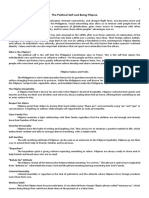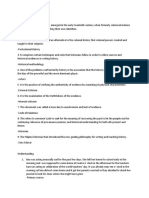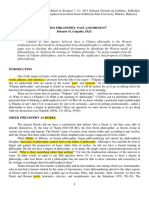GE 2 Midterm Exam Reviewer
GE 2 Midterm Exam Reviewer
Uploaded by
Brylle RoderosCopyright:
Available Formats
GE 2 Midterm Exam Reviewer
GE 2 Midterm Exam Reviewer
Uploaded by
Brylle RoderosCopyright
Available Formats
Share this document
Did you find this document useful?
Is this content inappropriate?
Copyright:
Available Formats
GE 2 Midterm Exam Reviewer
GE 2 Midterm Exam Reviewer
Uploaded by
Brylle RoderosCopyright:
Available Formats
GE 2 – Midterm Exam Reviewer
Reading in Philippine History
Why do we need to study History?
• Meaning and relevance of history
• To figure out the causation in history (what actions caused such history or event)
• To learn the past because we hole the future in our hands.
When did history begin?
• When mankind learned how to write and keep a record knowledge.
Source – an object from the past on which historians depend in order to create their own
depiction of that past.
Kinds of Sources
1. Written Sources – Books, Magazines, Journals, Diary
2. Non-written Sources – Oral History, Pictures, Video Recordings, Artifacts, Fossils
Types of Sources
1. Primary Sources – document first hand experiences of the event.
• Personal interviews
• Journals/diaries
• First-hand experience (your personal experience)
• Government records (Land title, birth certificate, cedula, etc…)
• Photographs
• Videos (Vlog entries too)
• Maps, Art, Film archives, Artifacts
2. Secondary Sources – sources based on the primary sources.
• Textbooks
• Magazine articles (non-biographical)
• Assignments (even copy-paste ones)
• Heard a story from a friend of a friend
➢ Secondary sources can still be used for history writing.
➢ Rumor or “chismis” can be used as a source.
Role of the Historian
History (istoria)
- inquiry or knowledge acquired by investigation.
- written documents written in the past.
Biases - personal, political, religious, personal idiosyncrasies.
Frame of Preference - a set of interlocking values, loyalties, assumptions, interests and
principles of actions.
➢ Historian is many times removed from the events under investigation.
➢ Historians rely on surviving records.
➢ History can change over time when presented with new evidence.
➢ History is not fiction.
➢ History not supported by evidence is worthless.
➢ Historians have to verify sources, to date them, locate their place of origin and identify
their intended functions.
Involves:
1. Selection of Subject
2. Collection of Sources
3. Examination of Genuineness
4. Extraction from Sources
➢ Test of Authenticity
- Determine the date of the document
- Determine the author (handwriting, signature, seal)
- Anachronistic style
- Anachronistic reference to events
- Provenance – determining genuineness
- Semantics – meaning of each text.
- Hermeneutics – determining ambiguities.
3 Major Components to Effective Historical Thinking
1. Sensitive to multiple causation
2. Sensitive to context
3. Awareness of the interplay of continuity and change in human affairs
Prehistory – events that occurred before written records.
Sources:
1. Artifacts - anything made by humans.
• Stone, Wood, Bone, Shell, and Glass Tools
• Ceramics
❖ Ecofacts – natural objects that have been used or affected by humans.
❖ Fossil – remains of a prehistoric organism found inside a rock.
❖ Features – a different kind of artifact that cannot be easily removed from
archeological sites.
2. Folklore – manner, customs, observances, songs, traditions
➢ Before Present (BP) – years as a time scale in archeology.
➢ Before Common Era (BCE) – before current era.
➢ Before Christ (BC) – before 1 AD.
You might also like
- GE 2 ReviewerDocument4 pagesGE 2 Reviewerbloodstained SenpaiNo ratings yet
- Topic 11 - Mercolino, Arcellas, LeysonDocument9 pagesTopic 11 - Mercolino, Arcellas, LeysonCarlos Lynnard MercolinoNo ratings yet
- Understanding History: A Primer of Historical Method by Louis GottschalkDocument10 pagesUnderstanding History: A Primer of Historical Method by Louis Gottschalkbry uyNo ratings yet
- MR-J2S-S099 - Specifications and Instruction Manual BCN-B11127-478 (01.02) PDFDocument84 pagesMR-J2S-S099 - Specifications and Instruction Manual BCN-B11127-478 (01.02) PDFDoDuyBacNo ratings yet
- Professional English For Students of Logistics PDFDocument187 pagesProfessional English For Students of Logistics PDFbiba100% (1)
- EGV Module2-NSTP1Document9 pagesEGV Module2-NSTP1Juliana BalibalosNo ratings yet
- Module 1: Sources and Criticism in HistoryDocument8 pagesModule 1: Sources and Criticism in HistoryFontano Nikko PaoloNo ratings yet
- Module 1 Lesson 3: Content Analysis "Customs of The Tagalogs"Document6 pagesModule 1 Lesson 3: Content Analysis "Customs of The Tagalogs"Sarah MitraNo ratings yet
- Reviewer FILI 101Document9 pagesReviewer FILI 101marklouied55No ratings yet
- History of Philippine Science and Technology 1Document24 pagesHistory of Philippine Science and Technology 1Deo Gratias PozonNo ratings yet
- Introduction of The Module Course Code: CWORLD1 Course Title: The Contemporary World Credit: Three (3) Units Course DescriptionDocument7 pagesIntroduction of The Module Course Code: CWORLD1 Course Title: The Contemporary World Credit: Three (3) Units Course DescriptionDarlene Dacanay DavidNo ratings yet
- Module 4 - GENEALOGICAL AND CULTURAL CONNECTIONS OF THE TRI-PEOPLE OF MINSUPALADocument18 pagesModule 4 - GENEALOGICAL AND CULTURAL CONNECTIONS OF THE TRI-PEOPLE OF MINSUPALAczelleah de gracia100% (1)
- Reading in Philippine HistoryDocument21 pagesReading in Philippine HistoryJenny AndalNo ratings yet
- Lesson 2Document25 pagesLesson 2Michelle Gutierrez SibayanNo ratings yet
- 3LMS GE 9 Ethics Study Guide For Module 3 Updated 02092021Document8 pages3LMS GE 9 Ethics Study Guide For Module 3 Updated 02092021Christine SeriosaNo ratings yet
- The Political Self and Being FilipinoDocument2 pagesThe Political Self and Being FilipinoLuie john MalimitNo ratings yet
- Topic 1 Week2 Readings in Philippine HistoryDocument27 pagesTopic 1 Week2 Readings in Philippine HistoryNorielyn DamasoNo ratings yet
- Gec 1 Chapter 2Document27 pagesGec 1 Chapter 2Ethan VercoloNo ratings yet
- Reflection PaperDocument1 pageReflection PaperFaizal MaligaNo ratings yet
- RPH Meaning of History 1Document10 pagesRPH Meaning of History 1ueue uueNo ratings yet
- The KKK and The "Kartilya NG Katipunan"Document29 pagesThe KKK and The "Kartilya NG Katipunan"Tykes MendozaNo ratings yet
- Chapter 2 Readings in The Philippine HistoryDocument12 pagesChapter 2 Readings in The Philippine Historyyennytobesa123No ratings yet
- Activity 3Document3 pagesActivity 3Aina HaravataNo ratings yet
- Ang Kartilya Ni Emilio Jacinto Group 5Document27 pagesAng Kartilya Ni Emilio Jacinto Group 5Sarah Quijan BoneoNo ratings yet
- Exercise 4.2.1: Comparing PoliticsDocument4 pagesExercise 4.2.1: Comparing PoliticsThraia GonzalesNo ratings yet
- Readings in Philippine HistorymoduleDocument126 pagesReadings in Philippine HistorymoduleDianna Bautista50% (2)
- Module 3 One Past But Many HistoriesDocument42 pagesModule 3 One Past But Many HistoriesClint Escabal MosenabreNo ratings yet
- Lipa City ResearchDocument8 pagesLipa City ResearchKlyde Mercado MacaraigNo ratings yet
- A. What A sourc-WPS OfficeDocument3 pagesA. What A sourc-WPS OfficeDominic BelenNo ratings yet
- Early Beginnings of Culture and SocietyDocument2 pagesEarly Beginnings of Culture and SocietyJarib CaanawanNo ratings yet
- Chapter 1 - Appreciating The Field of History: Ge 002 - Readings in Philippine HistoryDocument16 pagesChapter 1 - Appreciating The Field of History: Ge 002 - Readings in Philippine HistoryCristine Joy CalingacionNo ratings yet
- Rizal and The Propaganda MovementDocument20 pagesRizal and The Propaganda MovementLadybellereyann A TeguihanonNo ratings yet
- Chapter 1 - Introduction To History Definition ISSUES SOURCES and METHODOLOGYDocument14 pagesChapter 1 - Introduction To History Definition ISSUES SOURCES and METHODOLOGYrichard reyesNo ratings yet
- GEC 2 - The Kartilya of KatipunanDocument15 pagesGEC 2 - The Kartilya of KatipunanAquila Lynx Fornax FørsÿthêNo ratings yet
- Readings in Philippine HistoryDocument53 pagesReadings in Philippine HistoryAlison Ver SenobioNo ratings yet
- NSTP Midterms ReviewerDocument2 pagesNSTP Midterms ReviewerMark Jayson0% (1)
- Ge8 Art AppreDocument23 pagesGe8 Art Appregerald conejarNo ratings yet
- Issues and Questions in HistoryDocument14 pagesIssues and Questions in HistoryAlly AsiNo ratings yet
- Lesson 2 With Task SheetDocument19 pagesLesson 2 With Task SheetAngelica AyaganNo ratings yet
- Summary of First Voyage Around The World of Magellan by Antonio Pigafetta AuthorDocument4 pagesSummary of First Voyage Around The World of Magellan by Antonio Pigafetta AuthorJoy SolisNo ratings yet
- GMRCDocument18 pagesGMRCRegine Occiano VelardeNo ratings yet
- Filipino American RelationsDocument20 pagesFilipino American Relationsgustokongmaginghatdog2.1100% (2)
- Template - Ge 2 - Readings in Philippine History Module 2Document23 pagesTemplate - Ge 2 - Readings in Philippine History Module 2Kaye TieneNo ratings yet
- Unit 2-Topic 1-Physical SelfDocument9 pagesUnit 2-Topic 1-Physical SelfMab Shi100% (1)
- Readings in PH History Reviewer For The 1st ChapterDocument4 pagesReadings in PH History Reviewer For The 1st ChapterKay Santos FernandezNo ratings yet
- Multi Perspect I VityDocument16 pagesMulti Perspect I VityRobert Rodriguez100% (2)
- Great Books - Second Half AnswerDocument11 pagesGreat Books - Second Half AnswerJudy MagroNo ratings yet
- NSTP Quiz 4Document2 pagesNSTP Quiz 4Rosalinda Rubio SanicoNo ratings yet
- Lesson 5 Literacy AnalysisDocument8 pagesLesson 5 Literacy AnalysisRiza SanglayNo ratings yet
- "One Past But Many Histories" Controversies and Conflicting Views in Philippine HistoryDocument4 pages"One Past But Many Histories" Controversies and Conflicting Views in Philippine HistoryRAGOS Jeffrey Miguel P.No ratings yet
- Lesson 1 Hist1Document8 pagesLesson 1 Hist1Maria Charise TongolNo ratings yet
- Dost NSTPDocument5 pagesDost NSTPmark jayNo ratings yet
- Lesson 2 Reading in Phil HistoryDocument23 pagesLesson 2 Reading in Phil HistoryIrishkaye AguacitoNo ratings yet
- What Is The Primary Reason For The Author in Writing The Document? How Was It Produced?Document15 pagesWhat Is The Primary Reason For The Author in Writing The Document? How Was It Produced?Aubrey Sophia Magdasoc MisolaniaNo ratings yet
- Chapter 4 NSTPDocument7 pagesChapter 4 NSTPAlthea Faye RabanalNo ratings yet
- STS Report Outline1Document14 pagesSTS Report Outline1Gillian Amba100% (1)
- Chapter 3 Controversies and Conflicting Views in Philippine HistoryDocument14 pagesChapter 3 Controversies and Conflicting Views in Philippine HistoryCASIMERO, KENJI B.100% (1)
- Character As Moral CreativityDocument1 pageCharacter As Moral CreativityUnalyn UngriaNo ratings yet
- Filipino Philosophy Past and Present 201 PDFDocument14 pagesFilipino Philosophy Past and Present 201 PDFngoNo ratings yet
- Chapter 4 Identification of Historical ImportanceDocument7 pagesChapter 4 Identification of Historical ImportanceVionna BeaNo ratings yet
- Academic Account Manager Business Development in Philadelphia PA Resume Scott BardDocument2 pagesAcademic Account Manager Business Development in Philadelphia PA Resume Scott BardScottBardNo ratings yet
- ReviewDocument2 pagesReviewpeephunterNo ratings yet
- Greenhouse Effect: From Wikipedia, The Free EncyclopediaDocument4 pagesGreenhouse Effect: From Wikipedia, The Free EncyclopediaTSha MeunierNo ratings yet
- Ontology and EpistemologyDocument5 pagesOntology and EpistemologySania RiazNo ratings yet
- KaoliniteDocument2 pagesKaoliniteMarino ObsivacNo ratings yet
- Charter of ActivitiesDocument3 pagesCharter of ActivitiesAldrin M. ObiasNo ratings yet
- Wet DesignDocument1 pageWet DesigncharathNo ratings yet
- Types of SpeechDocument26 pagesTypes of SpeechJulieSanchezErsando75% (4)
- Core CoursesDocument3 pagesCore CoursesSammy EliasNo ratings yet
- تخطيط لوحات التوزيع للجهد المنخفضDocument39 pagesتخطيط لوحات التوزيع للجهد المنخفضAbdullah ALSHORBAJINo ratings yet
- M7350 (EU) 5.0 DatasheetDocument6 pagesM7350 (EU) 5.0 DatasheetPratpong KrasaesindhuNo ratings yet
- What Does The Track Parameter Mean in StaadDocument2 pagesWhat Does The Track Parameter Mean in Staadshafiullah100% (1)
- Numerical Simulation of Emulsion Flow Through Porous Media M.R. Islam S.M. Farouq AliDocument12 pagesNumerical Simulation of Emulsion Flow Through Porous Media M.R. Islam S.M. Farouq Alilulalala8888No ratings yet
- Resume Awang AsykalDocument1 pageResume Awang AsykalAWANG ASYKAL AWANG AHMADNo ratings yet
- Optical InstrumentsDocument30 pagesOptical InstrumentsSAWATI KUMARINo ratings yet
- GSK in ChinaDocument4 pagesGSK in ChinaHarshParmarNo ratings yet
- Terminal Velocity and How Air Resistance Is Impacted by Velocity (AutoRecovered)Document6 pagesTerminal Velocity and How Air Resistance Is Impacted by Velocity (AutoRecovered)petrNo ratings yet
- S4H Finance 1809 Whats New - Lars - F PDFDocument152 pagesS4H Finance 1809 Whats New - Lars - F PDFJonnie100% (1)
- Providing More Books Rather Than Investing in Ebooks and E-Journals For The LibraryDocument16 pagesProviding More Books Rather Than Investing in Ebooks and E-Journals For The LibraryjailaniNo ratings yet
- Univention Corporate ServerDocument133 pagesUnivention Corporate ServerNoé Ricardo Salazar GuzmanNo ratings yet
- Uniform Code of Ethics Business and It Professional EthicsDocument4 pagesUniform Code of Ethics Business and It Professional EthicsMuhammad Haris GinanjarNo ratings yet
- College Graduation SpeechDocument8 pagesCollege Graduation SpeechkomangNo ratings yet
- A Complex Mixture of ForcesDocument19 pagesA Complex Mixture of ForcesdrguillermomedinaNo ratings yet
- Poop StickDocument180 pagesPoop Stickflabbergaster12No ratings yet
- Detailed Training Program - HasibDocument10 pagesDetailed Training Program - HasibKaziRashidulAzamNo ratings yet
- TitleDocument1 pageTitleThiena CastorNo ratings yet
- I Sci 28 Friction On An InclineDocument2 pagesI Sci 28 Friction On An InclineZian Jolo CatacutanNo ratings yet
- Harridge-March 2004 - Electronic MarketingDocument13 pagesHarridge-March 2004 - Electronic MarketingPetru Daniel MilitaruNo ratings yet

























































































